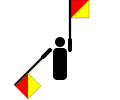K
|

K (named kay /ˈkeɪ/)[1] is the eleventh letter of the modern English alphabet and the ISO basic Latin alphabet. In English, the letter K usually represents the voiceless velar plosive.
History
| Egyptian hieroglyph D | Proto-Semitic K | Phoenician K |
Etruscan K | Greek Kappa | ||
|---|---|---|---|---|---|---|
|
|
|
|
|
The letter K comes from the Greek letter Κ (kappa), which was taken from the Semitic kap, the symbol for an open hand.[2] This, in turn, was likely adapted by Semites who had lived in Egypt from the hieroglyph for "hand" representing D in the Egyptian word for hand, d-r-t. The Semites evidently assigned it the sound value /k/ instead, because their word for hand started with that sound.[3]
In the earliest Latin inscriptions, the letters C, K and Q were all used to represent the sounds /k/ and /g/ (which were not differentiated in writing). Of these, Q was used to represent /k/ or /g/ before a rounded vowel, K before /a/, and C elsewhere. Later, the use of C and its variant G replaced most usages of K and Q. K survived only in a few fossilized forms such as Kalendae, "the calends".[4]
After Greek words were taken into Latin, the Kappa was transliterated as a C. Loanwords from other alphabets with the sound /k/ were also transliterated with C. Hence, the Romance languages generally use C and have K only in later loanwords from other language groups. The Celtic languages also tended to use C instead of K, and this influence carried over into Old English.
Use in writing systems
English
Today, English is the only Germanic language to productively use "hard" ⟨c⟩ (outside of the digraph ⟨ck⟩) rather than ⟨k⟩ (although Dutch uses it in learned words of Latin origin, and the pronunciation of these words follows the same hard/soft distinction as in English). The letter ⟨k⟩ is usually silent at the start of an English word when it comes before the letter ⟨n⟩, as in the words "knight," "knife," "knot," "know," and "knee".
Number
The SI prefix for a thousand is kilo-, officially abbreviated as k—for instance, prefixed to "metre" or its abbreviation m, kilometre or km signifies a thousand metres. As such, people occasionally represent the number in a non-standard notation by replacing the last three zeros of the general numeral with "K": for instance, 30K for 30,000.
Other languages
In most languages where it is employed, this letter represents the sound /k/ (with or without aspiration) or some similar sound.
Other systems
The International Phonetic Alphabet uses ⟨k⟩ for the voiceless velar plosive.
Related characters
Ancestors, descendants and siblings
- 𐤊 : Semitic letter Kaph, from which the following symbols originally derive
- Κ κ/ϰ : Greek letter Kappa, from which K derives
- К к : Cyrillic letter Ka, also derived from Kappa
- K with diacritics: Ƙ ƙ Ꝁ ꝁ Ḱ ḱ Ǩ ǩ Ḳ ḳ Ḵ ḵ
Ligatures and abbreviations
- ₭ : Lao kip
Computing codes
| Character | K | k | K | |||
|---|---|---|---|---|---|---|
| Unicode name | LATIN CAPITAL LETTER K | LATIN SMALL LETTER K | KELVIN SIGN | |||
| Encodings | decimal | hex | decimal | hex | decimal | hex |
| Unicode | 75 | U+004B | 107 | U+006B | 8490 | U+212A |
| UTF-8 | 75 | 4B | 107 | 6B | 226 132 170 | E2 84 AA |
| Numeric character reference | K | K | k | k | K | K |
| EBCDIC family | 210 | D2 | 146 | 92 | ||
| ASCII 1 | 75 | 4B | 107 | 6B | ||
- 1 Also for encodings based on ASCII, including the DOS, Windows, ISO-8859 and nMacintosh families of encodings.
Other representation
Other usage
- "K" replacing "C" in Satiric misspelling
- K is the unit symbol for the Kelvin temperature scale.
- K is the chemical symbol for the element potassium (K is an abbreviation of kalium, the Latin name for potassium).
- Triangle K
- Unit prefix
- K is the name of the principal character in Kafka's novel The Trial
- In chess notation, the letter K represents the King (WK for White King, BK for Black King).
- In baseball scoring, the letter K is used to represent a strikeout. A forwards oriented K represents a "strikeout swinging"; a backwards oriented K (
 ) represents a "strikeout looking".
) represents a "strikeout looking". - As abbreviation for OK, often used in emails and short text messages.
- K is used as a slang term for Ketamine among recreational drug users.
- In the CMYK color model, K represents black ink.
- In International Morse code it is used to mean "over".[5]
References
- ↑ "K" Oxford English Dictionary, 2nd edition (1989); Merriam-Webster's Third New International Dictionary of the English Language, Unabridged (1993); "kay," op. cit.
- ↑ "K". The Oxford English Dictionary, 2nd ed., 1977, online(registration required)
- ↑ Gordon, Cyrus H. (1970). "The Accidental Invention of the Phonemic Alphabet". Journal of Near Eastern Studies. 29 (3): 193. doi:10.1086/372069. JSTOR 543451.
- ↑ Sihler, Andrew L. (1995). New Comparative Grammar of Greek and Latin (illustrated ed.). New York: Oxford University Press. p. 21. ISBN 0-19-508345-8.
- ↑ Stephen Phillips (2009-06-04). "International Morse Code".
External links
-
 Media related to K at Wikimedia Commons
Media related to K at Wikimedia Commons -
 The dictionary definition of K at Wiktionary
The dictionary definition of K at Wiktionary -
 The dictionary definition of k at Wiktionary
The dictionary definition of k at Wiktionary


